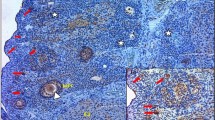Abstract
We aimed to characterize and to explore a treatment for a condition in which male mice exhibited a solid bulge in the preputial area and an inability to breed. Twenty-seven mice from several animal housing institutions in Spain were included in this study for microbiological and pathological characterization of this condition. The condition mostly affected breeding animals and was associated with the C57BL/6J genetic background. A solid, yellowish-white substance was found inside the prepuce, which displaced the penis cranially, preventing its externalization and limiting the animal's capacity to breed. This pattern was almost identical to that of post-coital vaginal plugs, suggesting that the blocking substance originated from ejaculate. Opposite to what was suggested in previous publications, the penis was completely intact in all of the cases, with no signs of mutilation or wounds. Based on our findings, we developed a surgical technique to clear the prepuce and recover breeding performance, which we tested in 15 other mice with the condition. We eliminated the blocking substance and recurrence of the condition by surgically opening the prepuce, and most of the animals recovered fertility.
This is a preview of subscription content, access via your institution
Access options
Subscribe to this journal
We are sorry, but there is no personal subscription option available for your country.
Buy this article
- Purchase on Springer Link
- Instant access to full article PDF
Prices may be subject to local taxes which are calculated during checkout



Similar content being viewed by others
References
Bendele, A.M. & Carlton, W.W. Incidence of obstructive uropathy in male B6C3F1 mice on a 24-month carcinogenicity study and its apparent prevention by ochratoxin A. Lab. Anim. Sci. 36, 282–285 (1986).
Hong, C.C. & Ediger, R.D. Self-mutilation of the penis in C57BL/6N mice. Lab. Anim. 12, 55–57 (1978).
Tuffery, A.A. Urogenital lesions in laboratory mice. J. Pathol. Bacteriol. 91, 301–309 (1966).
Bendele, A.M. Urologic syndrome, mouse. in Monographs on Pathology of Laboratory Animals 2nd edn (eds. Jones, T.C., Hard, G.C. & Mohr, U.) 456–462 (Springer, Berlin, Germany, 1998).
Wells, S., Trower, C., Hough, T.A., Stewart, M. & Cheeseman, M.T. Urethral obstruction by seminal coagulum is associated with medetomidine-ketamine anesthesia in male mice on C57BL/6J and mixed genetic backgrounds. J. Am. Assoc. Lab. Anim. Sci. 48, 296–299 (2009).
Rapp, J.P. Terminal formation of urethral plugs in male mice. Proc. Soc. Exp. Biol. Med. 111, 243–245 (1962).
Kunstýr, I., Küpper, W., Weisser, H., Naumann, S. & Messow, C. Urethral plug—a new secondary male sex characteristic in rat and other rodents. Lab. Anim. 16, 151–155 (1982).
Ninomiya, K. & Brown, R.E. Removal of the preputial glands alters the individual odors of male MHC-congenic mice and the preferences of females for these odors. Physiol. Behav. 58, 191–194 (1995).
Todorova, M.T. et al. Sexual dysfunction and sudden death in epileptic male EL mice: inheritance and prevention with the ketogenic diet. Epilepsia 44, 25–31 (2003).
Taylor, D.M. Urethral plugs and urine retention in male mice. Lab. Anim. 19, 189–191 (1985).
Babcock, V.I. & Southam, C.M. Obstructive uropathy in laboratory mice. Proc. Soc. Exp. Biol. Med. 120, 580–581 (1965).
Sokoloff, L. & Barile, M.F. Obstructive genitourinary disease in male STR/1N mice. Am. J. Pathol. 41, 233–246 (1962).
Taylor, D.M. & Fraser, H. Hydronephrosis in inbred strains of mice with particular reference to the BRVR strain. Lab. Anim. 7, 229–236 (1973).
Hong, C.C. & Ediger, R.D. Perputial gland abscess in mice. Lab. Anim. Sci. 28, 153–156 (1978).
Needham, J.R. & Cooper, J.E. Bulbourethral gland infections in mice associated with Staphylococcus aureus. Lab. Anim. 10, 311–315 (1976).
Sebesteny, A. Abscesses of the bulbourethral glands of mice due to Pasteurella pneumotropica. Lab. Anim. 7, 315–317 (1973).
Molina-Cimadevila, M.J. et al. Oral self-administration of buprenorphine in the diet for analgesia in mice. Lab. Anim. 48, 216–224 (2014).
Fox, J.G. et al. (eds.) The Mouse in Biomedical Research: Diseases (Academic Press, 2006).
Acknowledgements
We thank our colleagues and technicians at all of the animal housing institutions involved in this study for their enthusiastic work and support, especially Isabel Blanco, Carmen Checa, Sandra González, Veronica Jiménez, Ana Lorena Marin, Patricia Muñoz, Sonia Segura, Rebecca Ortiz, Lucia Yuste, Cristina Martí, Carolina Zamora, Rebeca Sanchez, Vicenta Jaraba, Marc Solé, Anabel Cónsul, Carla Lorente, Pilar Castañeda, Adoración Rodríguez, Mercedes Díaz Sarmiento and Carlos Mateos Díaz. We also thank Dr. Enrique de Madaria and Juan Ramos for their review of the manuscript, Juan Antonio Camara and Diego Echevarría for their valuable help with image editing and Dr. Marta Casado for her suggestions and advice.
Author information
Authors and Affiliations
Corresponding author
Ethics declarations
Competing interests
The authors declare no competing financial interests.
Rights and permissions
About this article
Cite this article
Molina-Cimadevila, M., García-Robles, T., Muñoz-Mediavilla, C. et al. Treatment and re-characterization of mouse obstructive genitourinary syndrome. Lab Anim 45, 225–232 (2016). https://doi.org/10.1038/laban.1024
Received:
Accepted:
Published:
Issue Date:
DOI: https://doi.org/10.1038/laban.1024



